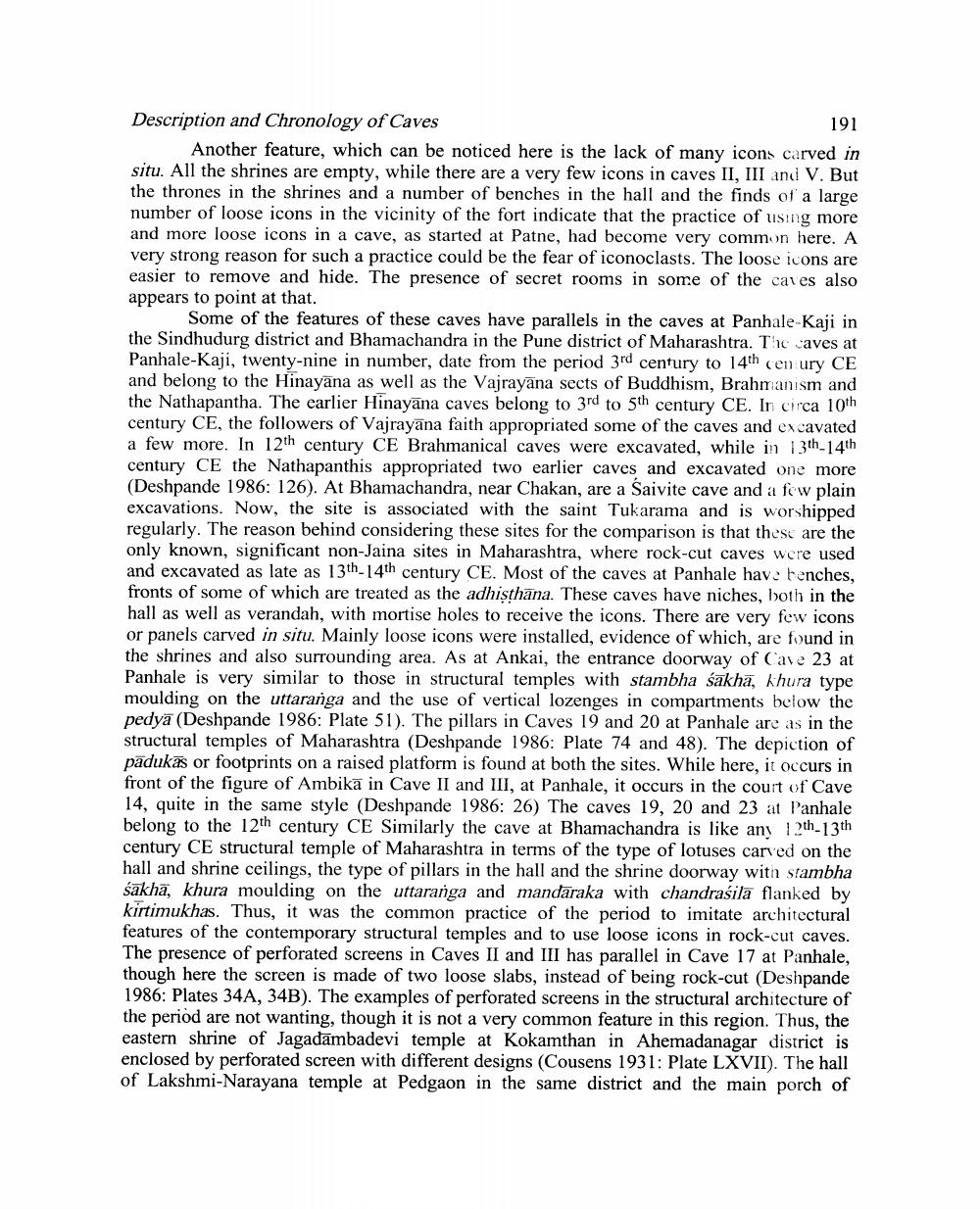________________
Description and Chronology of Caves
191 Another feature, which can be noticed here is the lack of many icons carved in situ. All the shrines are empty, while there are a very few icons in caves II, III and V. But the thrones in the shrines and a number of benches in the hall and the finds of a large number of loose icons in the vicinity of the fort indicate that the practice of using more and more loose icons in a cave, as started at Patne, had become very common here. A very strong reason for such a practice could be the fear of iconoclasts. The loose icons are easier to remove and hide. The presence of secret rooms in some of the caves also appears to point at that.
Some of the features of these caves have parallels in the caves at Panhale-Kaji in the Sindhudurg district and Bhamachandra in the Pune district of Maharashtra. The waves at Panhale-Kaji, twenty-nine in number, date from the period 3rd century to 14th cen ury CE and belong to the Hinayāna as well as the Vajrayāna sects of Buddhism, Brahmanism and the Nathapantha. The earlier Hinayāna caves belong to 3rd to 5th century CE. In circa 10th century CE, the followers of Vajrayana faith appropriated some of the caves and excavated a few more. In 12th century CE Brahmanical caves were excavated, while in 13th-14th century CE the Nathapanthis appropriated two earlier caves and excavated one more (Deshpande 1986: 126). At Bhamachandra, near Chakan, are a Saivite cave and a few plain excavations. Now, the site is associated with the saint Tukarama and is worshipped regularly. The reason behind considering these sites for the comparison is that these are the only known, significant non-Jaina sites in Maharashtra, where rock-cut caves were used and excavated as late as 13th-14th century CE. Most of the caves at Panhale have benches, fronts of some of which are treated as the adhisthana. These caves have niches, both in the hall as well as verandah, with mortise holes to receive the icons. There are very few icons or panels carved in situ. Mainly loose icons were installed, evidence of which, are found in the shrines and also surrounding area. As at Ankai, the entrance doorway of Cave 23 at Panhale is very similar to those in structural temples with stambha sakha, khura type moulding on the uttaranga and the use of vertical lozenges in compartments below the pedyā (Deshpande 1986: Plate 51). The pillars in Caves 19 and 20 at Panhale are as in the structural temples of Maharashtra (Deshpande 1986: Plate 74 and 48). The depiction of padukas or footprints on a raised platform is found at both the sites. While here, it occurs in front of the figure of Ambikā in Cave II and III, at Panhale, it occurs in the court of Cave 14, quite in the same style (Deshpande 1986: 26) The caves 19, 20 and 23 at Panhale belong to the 12th century CE Similarly the cave at Bhamachandra is like any 12th-13th century CE structural temple of Maharashtra in terms of the type of lotuses carved on the hall and shrine ceilings, the type of pillars in the hall and the shrine doorway with stambha sakha, khura moulding on the uttaranga and mandaraka with chandrašila flanked by kirtimukhas. Thus, it was the common practice of the period to imitate architectural features of the contemporary structural temples and to use loose icons in rock-cut caves. The presence of perforated screens in Caves II and III has parallel in Cave 17 at Panhale, though here the screen is made of two loose slabs, instead of being rock-cut (Deshpande 1986: Plates 34A, 34B). The examples of perforated screens in the structural architecture of the period are not wanting, though it is not a very common feature in this region. Thus, the eastern shrine of Jagadambadevi temple at Kokamthan in Ahemadanagar district is enclosed by perforated screen with different designs (Cousens 1931: Plate LXVII). The hall of Lakshmi Narayana temple at Pedgaon in the same district and the main porch of




